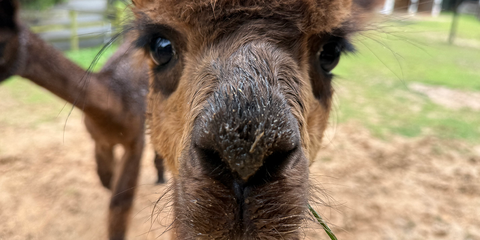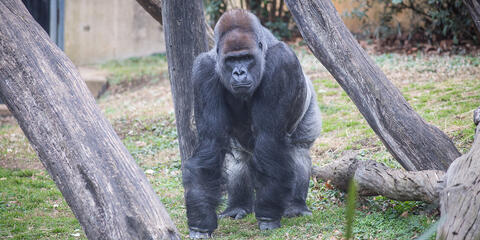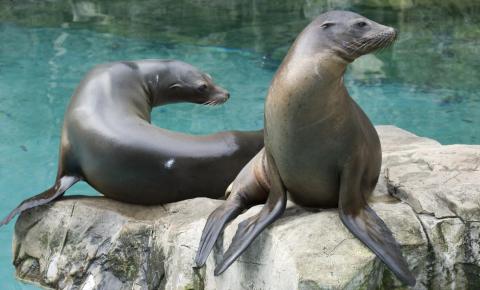Golden lion tamarins are small, social primates with reddish-gold coats and long, backswept manes. They live in the Atlantic coastal regions of southeastern Brazil, where their populations once dwindled to just 200 individuals. Thanks to intensive conservation efforts, this endangered species is recovering.
Physical Description
Their signature mane covers the ears and frames the dark, almost bare face. They have narrow hands and feet, long canine teeth, and short incisor teeth like other tamarins and marmosets.
Size
Golden lion tamarins are small monkeys, weighing 17 to 24 ounces (482 to 680 grams) and measuring 6 to 10 inches (15 to 25 centimeters) in length with a tail of about 12 to 15 inches (32 to 40 centimeters). Males and females are similar in appearance and size.
Native Habitat
Golden lion tamarins live in the heavily populated Atlantic coastal regions of southeastern Brazil. They live in humid forests with many vines, bromeliads, and other epiphytes. They occupy the closed canopy, often remaining 29 to 100 feet (10 to 30 meters) off the ground.
Lifespan
The first year of life is the most difficult for golden lion tamarins; 50 percent of infants die during this time. The remaining individuals usually live for about eight years and can live up to 20 years or more in human care.
Communication
These tamarins are territorial and defend their area with scent markings and vocalized threats. Signs of aggression include an open mouth, an arched back, and staring.
Food/Eating Habits
Golden lion tamarins are omnivorous, feeding on fruits, insects, and small invertebrates. Any smaller animal is possible food. They use their long, slender fingers and hands to probe into crevices, bark, bromeliads and other hiding places for their prey. These tamarins share food with their family groups, but rarely share food with others outside their family. Juveniles, for example, playfully steal food from parents or siblings.
At the Smithsonian's National Zoo, golden lion tamarins eat fruits, carrots, sweet potatoes, green beans, hard-boiled eggs, mealworms, crickets, and a marmoset gel.
Sleep Habits
Their sleep patterns are regular, meaning that they sleep from dusk until sunrise, oftentimes with a midday nap. Golden lion tamarins sleep in tree holes for warmth and protection from predators at night.
Social Structure
As with other lion tamarins, golden lion tamarins are a social species. In the wild, they live in groups of two to eight family members. The groups comprise a breeding pair, offspring of one or two litters and possibly other relatives. Golden lion tamarins groom much like other primates. The juveniles play, chasing and wrestling with each other.
Reproduction and Development
Each group has one breeding pair. The breeding season is between September and March, the warmest and wettest time of year. After a gestation period of about four and a half months, the female usually gives birth to twins. Golden lion tamarins are born fully furred with their eyes open. They cling to their mothers for the first few weeks. All members of the group will carry and care for the infants, but the adult male usually does the largest share. The mother only takes the babies to nurse them. After about five weeks, babies begin to explore on their own; they are weaned at 3 months. As with golden-headed lion tamarins, sexual maturity is reached at 18 months for females and 2 years for males.
Conservation Efforts
Historically, collection for the pet trade, severe habitat loss and fragmentation were the primary threats to golden lion tamarins. Habitats were destroyed to make way for sugar cane and coffee production, cattle grazing, logging, charcoal and urbanization. As a result, in the early 1970s, there were as few as 200 golden lion tamarins in the wild.
In 1972, the Zoo held a ground-breaking conference bringing together 28 European, American and Brazilian biologists to save the golden lion tamarin. Long-term recommendations for husbandry were developed for research and conservation activities, including support for the breeding program in Brazil, studies of breeding biology, protocols for captive husbandry and management, medical programs, hand-rearing guidelines, inter-institutional cooperation and the establishment of a studbook and a data bank to record all aspects of their propagation in human care.
Following this important meeting, the Zoo made a major commitment to the captive breeding and conservation of the golden lion tamarin and launched a long-term investigation into the reproduction, social behavior and husbandry of the species in human care. For many years, golden lion tamarins were free-ranging at the Zoo to help them prepare for eventual reintroduction to the wild in Brazil.
The zoo population of golden lion tamarins has been managed globally since 1973. In 1981, golden lion tamarins became one of the first species to be designated as part of the Association of Zoos & Aquariums’ Species Survival Plan, with 143 zoos participating in the captive breeding program.
The Zoo played an important role in creating the Golden Lion Tamarin Conservation Program, which is still active today in field research, reintroduction, environmental education and habitat restoration. Currently, the International Committee for the Conservation and Management of Lion Tamarins advises the Brazilian government on the research and conservation activities for these species.
Golden lion tamarins were upgraded from critically endangered to endangered in 2003 following these extensive conservation efforts. About one-third of the wild population today originated from golden lion tamarins raised in human care. About 2,500 golden lion tamarins live in the wild, most in or near the Reserva Biologica de Poço das Antas in the state of Rio de Janeiro, and an additional 500 are in zoos worldwide.
While the estimate of golden lion tamarins living in the wild has continued to rise in recent years, they are still classified as endangered because their habitat remains fragmented into small, unconnected areas, each only capable of supporting a small number of groups. This has decreased the quality of tamarin habitat and limited their ability to grow populations. It also leaves the species susceptible to diseases. Without intervention, inbreeding will contribute to the local extinction of many of these small populations, and eventually the entire species.
Continued conservation efforts, such as reforestation and the creation of wildlife corridors, are essential to sustain and grow the overall population, and to ensure all of the hard work put into saving golden lion tamarins is not undone.
Help this Species
- Reduce, reuse and recycle — in that order! Cut back on single-use goods, and find creative ways to reuse products at the end of their life cycle. Choose recycling over trash when possible.
- Be a smart consumer. Choose products made with sustainable ingredients, such as Smithsonian certified Bird Friendly coffees, which support farmers striving to limit their impact on wildlife and habitat.
- Support organizations like the Smithsonian’s National Zoo and Conservation Biology Institute that research better ways to protect and care for this animal and other endangered species. Consider donating your time, money or goods.
Animal News

Zoo Welcomes Alpacas ‘Rainstorm’ and ‘Coffee Cup’


